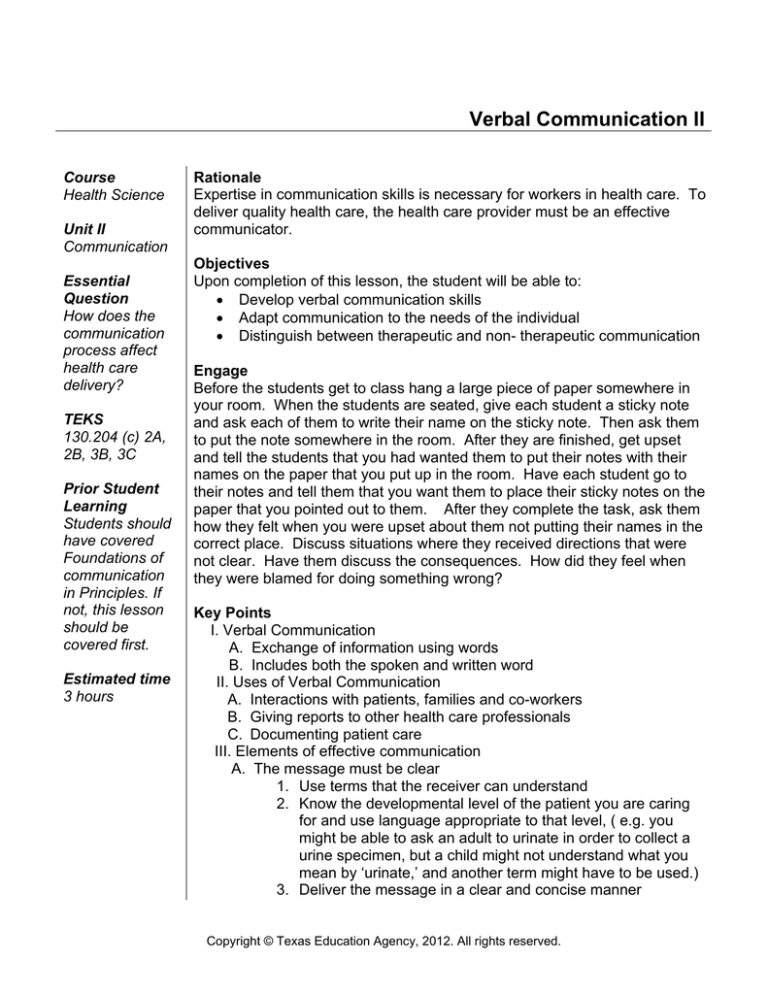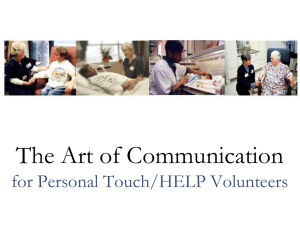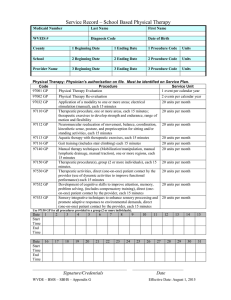Verbal Communication II
advertisement

Verbal Communication II Course Health Science Unit II Communication Essential Question How does the communication process affect health care delivery? TEKS 130.204 (c) 2A, 2B, 3B, 3C Prior Student Learning Students should have covered Foundations of communication in Principles. If not, this lesson should be covered first. Estimated time 3 hours Rationale Expertise in communication skills is necessary for workers in health care. To deliver quality health care, the health care provider must be an effective communicator. Objectives Upon completion of this lesson, the student will be able to: Develop verbal communication skills Adapt communication to the needs of the individual Distinguish between therapeutic and non- therapeutic communication Engage Before the students get to class hang a large piece of paper somewhere in your room. When the students are seated, give each student a sticky note and ask each of them to write their name on the sticky note. Then ask them to put the note somewhere in the room. After they are finished, get upset and tell the students that you had wanted them to put their notes with their names on the paper that you put up in the room. Have each student go to their notes and tell them that you want them to place their sticky notes on the paper that you pointed out to them. After they complete the task, ask them how they felt when you were upset about them not putting their names in the correct place. Discuss situations where they received directions that were not clear. Have them discuss the consequences. How did they feel when they were blamed for doing something wrong? Key Points I. Verbal Communication A. Exchange of information using words B. Includes both the spoken and written word II. Uses of Verbal Communication A. Interactions with patients, families and co-workers B. Giving reports to other health care professionals C. Documenting patient care III. Elements of effective communication A. The message must be clear 1. Use terms that the receiver can understand 2. Know the developmental level of the patient you are caring for and use language appropriate to that level, ( e.g. you might be able to ask an adult to urinate in order to collect a urine specimen, but a child might not understand what you mean by ‘urinate,’ and another term might have to be used.) 3. Deliver the message in a clear and concise manner Copyright © Texas Education Agency, 2012. All rights reserved. a. good grammar and correct pronunciation are essential b. avoid slang terms, words with double meanings, or meaningless phrases such as “you know”, or “all that stuff” c. the tone and pitch of voice are important d. do not speak too fast or too slowly e. in written communication, the message should be spelled correctly, contain correct grammar, proper punctuation, and it should be concise 4. The receiver must be able to hear and receive the message a. patients may be heavily medicated, have a hearing or vision loss, or speak a different language b. use alternate ways to communicate such as writing the message out, using an interpreter, or repeating the message 5. The receiver must be able to understand the message a. use terms the patient understands b. the patient’s attitudes and prejudices may interfere with understanding (e.g. if they don’t have confidence in the health care worker, they may not accept the message) c. the health care worker’s attitudes and prejudices may interfere with understanding, ( e.g. if the health care worker feels that the patient is uncooperative, they may not respond correctly to the patient) 6. Interruptions or distractions must be avoided a. trying to talk while answering the phone or writing a message will decrease the effectiveness of communication b. environmental factors may affect communication, (e.g. uncomfortable temperatures or loud noises such as a loud TV or radio may interfere with communication) B. Conversation (exchange of verbal communication) skills 1. Control the tone of your voice: convey interest instead of boredom, patience rather than anger 2. Be knowledgeable about the topic of conversation: be honest and confident 3. Be flexible: you may want to discuss a certain subject and the patient wants to discuss something else 4. Be clear and concise: stay on one subject at a time 5. Avoid words that might have different interpretations 6. Be truthful 7. Keep an open mind: patients and other health care workers have valuable contributions Copyright © Texas Education Agency, 2012. All rights reserved. Page 2 of 7 8. Take advantage of available opportunities C. Therapeutic Communication Skills 1. Listening a. sit when communicating with the patient b. be alert and relaxed and take sufficient time c. maintain eye contact d. indicate that you are paying attention to what the patient is saying 2. Silence a. take the time to wait for the patient to initiate or to continue speaking b. allow the patient and health care worker time to reflect on what has been said and to collect thoughts 3. Offering Self: Can I help in some way? a. shows caring and concern b. shows readiness to help 4. Reflection: repeating what the patient has said a. validation that this is what was meant b. encourages further verbalization 5. Encouraging Elaboration: Tell me how that felt. a. used to elicit information about a subject b. helps the patient clarify unclear thoughts or ideas 6. General Leading Statements: Go on. I see. a. used to get interaction started b. encourages patient to continue or elaborate 8. Giving Information: The test results take 48 hours to return to us. a. Informs the patient of specific information relevant to their health care b. Requires feedback to make sure the patient receives the correct information 9. Open Ended Questions: “Tell me about your day,” rather than, “How was your day?” a. Encourages elaboration rather than a 1 or 2 word answer b. Creates an inviting atmosphere for sharing thoughts, and feelings D. Non-Therapeutic Communication Skills 1. Don’t use clichés: Everything will be O.K. You don’t need to worry about that. a. offers false reassurance b. can be interpreted as there is no cause for concern 2. Don’t use questions beginning with why or how a. requesting an explanation b. puts patient or co-worker on the defensive 3. Don’t give advice Copyright © Texas Education Agency, 2012. All rights reserved. Page 3 of 7 a. denies the patient the right to make their own decisions b. increases patient’s dependence on health care providers 4. Don’t keep changing the subject a. may keep the patient from talking about what is a concern to him/her b. indicates that the health care worker is ignoring the patient 5. Don’t use judgmental comments: You aren’t acting very grown up, How do you think they would feel if they saw you like this? a. imposes the health care worker’s feelings on the patient b. belittles what the patient is feeling IV. Gender Bias A. Words used often reflect a gender role bias: All nurses are female. B. Gender roles have changed in the past ten years C. To eliminate bias, avoid referring to doctors as male and nurses as female -- address the person by name or title Activity I. Complete Therapeutic and Non-therapeutic Activity. Assessment Successful completion of the therapeutic and non- therapeutic activity Materials Therapeutic and non-therapeutic activity Therapeutic and non-therapeutic key Accommodations for Learning Differences For reinforcement, students will identify terms and phrases used by family members which may be misunderstood by a health care provider. For enrichment, students will interview someone from a different culture to determine complications encountered in a health care setting as a result of poor communication. National and State Education Standards National Health Care Standards HLC02 Communications Health Care Workers will know the various methods of giving and obtaining information. They will communicate effectively both orally and in writing. Copyright © Texas Education Agency, 2012. All rights reserved. Page 4 of 7 TEKS 130.204(c)2A demonstrate therapeutic communication appropriate to the situation; 130.204(c)2B execute verbal and non-verbal skills when communicating with persons with sensory and language barriers; 130.204(c)3B demonstrate communication skills in building and maintaining health relationships; and 130.204(c)3C demonstrate strategies for communicating needs, wants and emotions. Texas College and Career Readiness Standards English/Language Arts Speaking III B Develop effective speaking styles for both group and one-on-one situation Listening IV A Apply listening skills as an individual and as a member of a group in a variety of settings IV B Listen effectively in informal and formal situations Social Studies Effective Communication V A clear and coherent oral and written communication Copyright © Texas Education Agency, 2012. All rights reserved. Page 5 of 7 Therapeutic and Non-Therapeutic Communication Identify the communication techniques used with each patient and decide if it is therapeutic or non-therapeutic. If you choose non-therapeutic, please write two alternative responses. Situation I Mrs. James, 20 years old, was in a car accident three days ago. In addition to having a fractured leg, she has multiple bruises and lacerations to her face. She comes to Physical Therapy to learn to walk with crutches. She tells the Physical Therapist, “I won’t be able to face my friends. I look like a freak.” The Physical Therapist replies, “Don’t worry about such things. You’ll heal fine.” Type of technique Therapeutic or non-therapeutic Revisions: Situation II Mr. Smith, 40 years old, was admitted on the evening shift with a urinary tract infection. As you are making rounds at midnight, you notice that he is awake. When you ask if you can do anything for him, he responds, “I can’t seem to go to sleep. My wife was just diagnosed with cancer, and I am so worried about it, I am having a hard time sleeping.” The nurse says, “I think it is time for your vital signs now. Let me get the IVAC and I will get those right away.” Type of technique: Therapeutic or non-therapeutic: Revisions: Situation III You are working in a pharmacy. A patient comes in with a prescription to be filled. As you check the prescription, she says, “The Doctor told me what this medication is for but I didn’t understand him.” After checking with the pharmacist, you tell her; “This medication is to help lower your blood pressure. It should be taken once a day at the same time each day.” Type of technique: Therapeutic or non-therapeutic: Revisions: Copyright © Texas Education Agency, 2012. All rights reserved. Page 6 of 7 Therapeutic and Non-Therapeutic Communication KEY 1. Using Clichés Non-Therapeutic Possible Revisions: Go on. Offering general leading comments Silence Tell me more about how you are feeling. Encouraging patient to elaborate 2. Changing the subject Non-therapeutic Possible revisions: “I am here to listen if you would like to talk about it.” Offering self Diagnosed with cancer . . . Reflection 3. Offering Information Therapeutic No revisions needed Copyright © Texas Education Agency, 2012. All rights reserved. Page 7 of 7





